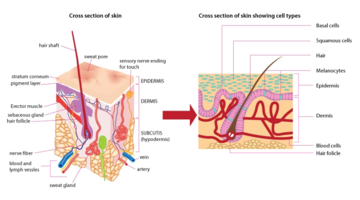Hayley Reynolds (Auckland Bioengineering Institute) and Associate Professor Rod Dunbar (University of Auckland) explain the effect of UV on melanocytes.
Acknowledgements:
Dr Roger Uren
Henry Cavillones
Ed Tarwinski
Carita Bonita
Sunny Ripert
American Society of Clinical Oncology
Transcript
HAYLEY REYNOLDS
A melanoma is cancer of the skin. There are three different types of skin cancer, but melanoma is the most aggressive and it’s the most serious. It can spread very quickly throughout the body, and it’s a cancer of the pigment cells in the skin, which are called melanocytes.
DR ROD DUNBAR
These are the cells that would normally contribute to skin pigmentation, so different ethnic groups have different skin colour – that’s because their cells called melanocytes make different levels of pigment. Those cells are also the same cells that respond to ultraviolet light, and induce the tanning response. So in fairer skin people, particularly you notice, when exposed to UV light over time, the skin colour changes, and that is because the cells inside the skin – the melanocytes – make more pigment in response to UV, and this is probably a protective response to prevent UV damaging the cells lower down.
These melanocytes are sitting in the middle of the skin, if you look at it in cross section, effectively between the epidermis and the dermis. And they usually sit on their own, and they have long finger-like projections, like a tree branch almost, that push out into the gaps between cells. And this then allows them to make pigment and to push it into other cells.
In many of us, there are collections of melanocytes, which are the moles and freckles. In some cases, these collections of melanocytes can become cancerous, and what that means is that the cells there don't just collect as a group, but they also start to grow, and when cells divide, as in any part of the body, the collection starts to look bigger and bigger and bigger, and so one of the first signs of a melanoma developing is a mole that changes in size.
The other thing that melanoma cells do, as they start to grow, is they start to burrow into the skin. It is a common thing in cancer that the cells start to lose the normal relationships with their neighbours. Normally, cells are very tightly constrained to a neighbourhood – as if you can't move out of a certain number of blocks of your city. When cells start to turn cancerous, one of the things that makes them so dangerous is that they start to roam in other parts of the body. And they can arrive in parts of the body where they grow very very well, and they start to disrupt the function of that part of the body.



